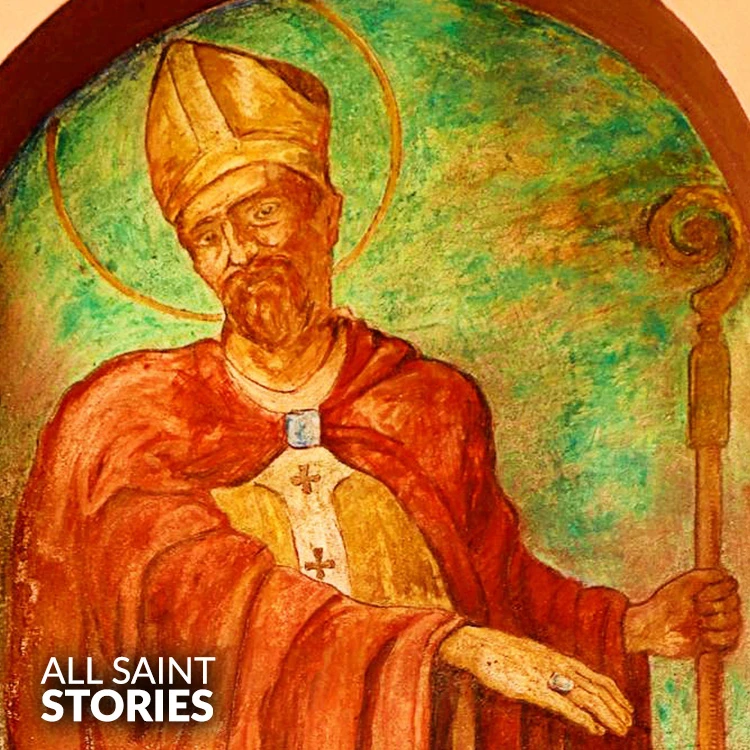"Saint Anastasius of Pavia, faithful servant of Christ, intercede for us before the Lord. May your courage and devotion inspire us to live with faith and charity, and to remain steadfast in our trust in God's will. Help us to overcome trials and challenges, and lead us to a deeper understanding of His love. Through your prayers, may we find peace and strength in His grace. Amen."
ST. ANASTASIUS OF PAVIA
ST. ANASTASIUS OF PAVIA

St. Anastasius of Pavia was a 7th-century bishop known for his pastoral leadership and defense of the Church during turbulent times in Italy. Respected for his wisdom and holiness, he served the people of Pavia with dedication, particularly during the conflicts of the Lombard period. He is venerated for his courage, fidelity, and contribution to the unity of the Church. His feast day is celebrated on March 3.
St. Anastasius of Pavia, also known as Anastasius I, was a bishop in northern Italy during the 7th century. He lived during a period marked by political instability and doctrinal challenges, particularly as the Lombards, a Germanic people who had settled in Italy, were still embracing Christianity. Anastasius became the bishop of Pavia, a historically significant diocese that would later be known as a strong center of Catholic orthodoxy in medieval Italy.
Little is known about his early life, but his reputation as a man of profound faith and keen intellect earned him recognition among his contemporaries. Pavia, at that time, was under the influence of the Lombard Kingdom, which had only recently begun to embrace Catholic Christianity over Arianism—a major theological heresy of the time that denied the full divinity of Christ. As bishop, Anastasius worked not only to shepherd the faithful of Pavia but also to foster unity between Roman Catholics and the newly converted Lombards.
He was deeply respected as a spiritual leader and teacher of orthodoxy. Throughout his episcopate, he remained steadfast in preserving the authority of the Church, promoting ecclesiastical discipline, and defending Catholic doctrine. His leadership was marked by compassion and a commitment to pastoral care, especially during periods of social and religious uncertainty.
Anastasius was also noted for his humility and deep devotion to prayer. He sought no personal glory, and his writings and actions demonstrated a bishop wholly devoted to Christ and his people. Although historical records about specific events in his episcopate are sparse, his legacy lived on through the reverence shown to him in the centuries that followed.
St. Anastasius died around the year 680 AD. His death occurred on March 3, the same day that would later be designated his feast day. He was buried in Pavia, and over time, his veneration grew among the local faithful and beyond. Like many early saints, his canonization occurred before the formal process was developed; he was proclaimed a saint by the acclamation of the faithful and the tradition of the early Church.
In art and iconography, St. Anastasius is typically depicted in episcopal robes, holding a crosier, symbolizing his role as bishop. Although he may not be as widely known as other saints from his era, his quiet and steady leadership in the diocese of Pavia left a lasting spiritual legacy.
Today, St. Anastasius of Pavia serves as a model of integrity, leadership, and unwavering dedication to the truth of the Gospel. His feast day, March 3, offers an opportunity to reflect on the importance of faith-filled leadership and the enduring strength of those who quietly uphold the mission of the Church in times of trial.
Video Not Found
No images uploaded for this saint yet.
The information on this website is compiled from various trusted sources. While we aim for accuracy, some details may be incomplete or contain discrepancies.
If you notice any errors or have additional information about this saint, please use the form on the left to share your suggestions. Your input helps us improve and maintain reliable content for everyone.
All submissions are reviewed carefully, and your personal details will remain confidential. Thank you for contributing to the accuracy and value of this resource.
Credits & Acknowledgments
- Anudina Visudhar (Malayalam) – Life of Saints for Everyday
by Msgr. Thomas Moothedan, M.A., D.D. - Saint Companions for Each Day
by A. J. M. Mausolfe & J. K. Mausolfe - US Catholic (Faith in Real Life) – Informational articles
- Wikipedia – General reference content and images
- Anastpaul.com – Saint images and reflections
- Pravachaka Sabdam (Malayalam) – Saint-related content and insights
We sincerely thank these authors and platforms for their valuable contributions. If we have unintentionally missed any attribution, please notify us, and we will make the correction promptly.
If you have any suggestion about ST. ANASTASIUS OF PAVIA
Your suggestion will help improve the information about this saint. Your details will not be disclosed anywhere.
© 2025 Copyright @ www.allsaintstories.com

 English
English
 Italian
Italian
 French
French
 Spanish
Spanish
 Malayalam
Malayalam
 Russian
Russian
 Korean
Korean
 Sinhala
Sinhala
 Japanese
Japanese
 Arabic
Arabic
 Portuguese
Portuguese
 Bantu
Bantu
 Greek
Greek
 German
German
 Dutch
Dutch
 Filipino
Filipino